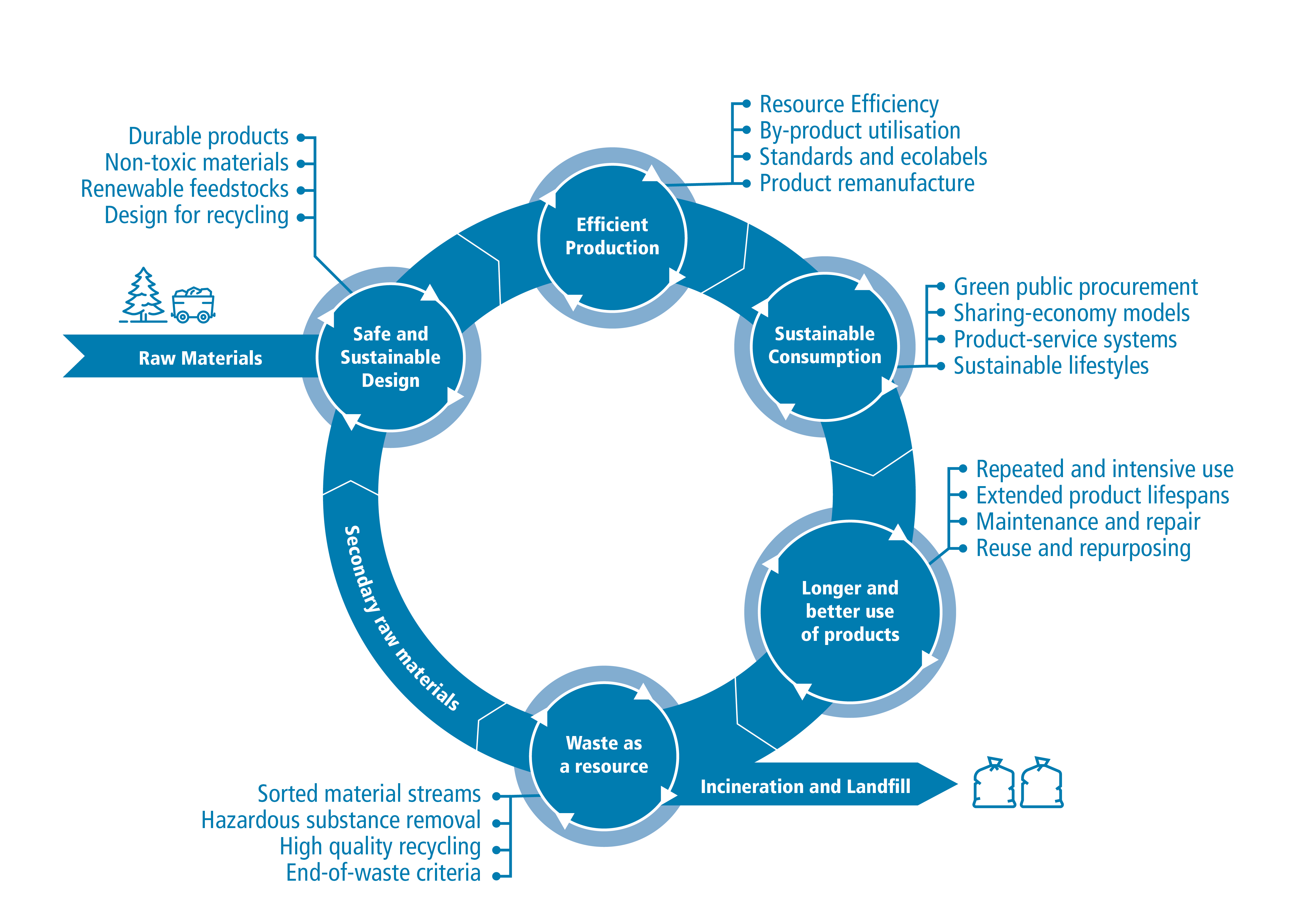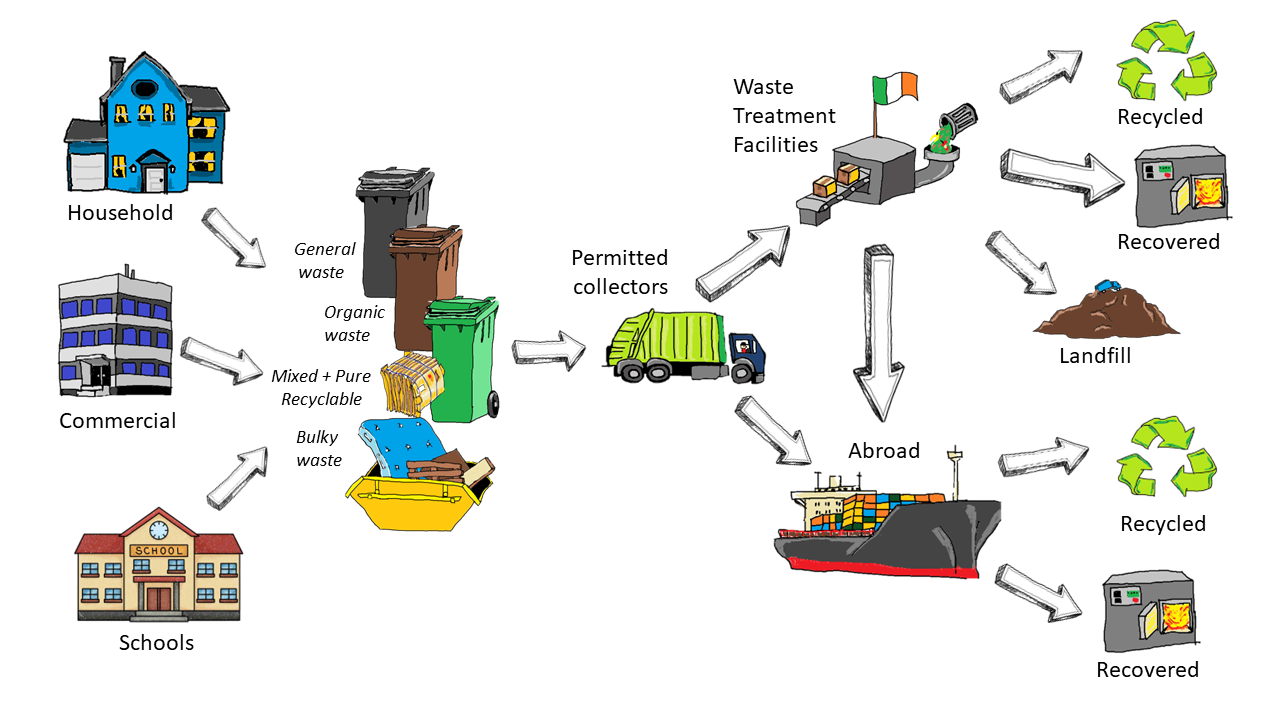FAQs on Circular Economy
-
What is a Circular Economy?
A circular economy is a way of using resources that minimizes waste, pollution, and environmental impact. In a circular economy, waste and primary raw material use are minimised by maintaining the value of products and materials for as long as possible. Resources are kept within the economy for as long as possible – products are used for longer or reused again and again. When they do reach the end of their life, products are repurposed as secondary raw materials and create further value. They can be used to recreate the same product or something new. The 2020 EU Circular Economy Action Plan focuses on accelerating the transition of Europe’s economy towards a more circular model. Ireland’s national waste policy was published in 2020: A Waste Action Plan for a Circular Economy.
The Ellen Mc Arthur Foundation has information on Circular Economy, Climate Change, and the impacts of waste on our Climate: Ellen MacArthur Foundation.

-
Consumption and the Circular Economy
At the current rate of consumption, we will need three planets to meet our resource demands by 2050. To correct this unsustainable trend, we must focus on reducing consumption and thereby reducing waste. To reduce consumption, we must reconsider all aspects of our economy in the context of a Circular Economy: how we prevent waste generation and resource consumption, how we design products to be safe and sustainable, how we consume materials and resources, and how we extend the productive life of all goods and products.
-
How much waste do we make per year?
Ireland generates many millions of tonnes of waste every year, including construction & demolition, municipal (household and similar) waste, packaging, food, hazardous etc.
The waste that people see in everyday life is that collected in wheelie bins from homes, schools, shops and businesses is called municipal waste and it only makes up a fraction of the overall waste generated. Of that municipal waste, less than half is recycled (visit the National Waste Statistics Waste Characterization site and the Highlights Report for up to date figures). To see how much waste is generated by material type, visit the Waste generation page.
-
Where can I find up-to-date statistics about waste?
EPA’s National Waste Statistics webpage is updated yearly. The EPA also publishes a Waste Statistics Release calendar so you can track when new data will be available. You can find more information by checking out the Latest National Waste Stats Publications.
-
What happens to my waste?
Waste is presented for collection in bins or skips and sometimes bales of pure materials such as cardboard or plastic from business, shops and industry. The waste is segregated into residual waste, recyclables and organic waste.

Waste is collected by permitted collectors that are authorised by the National Waste Collection Permit Office (NWCPO). These permitted collectors report annually on the types of waste collected and on where it is brought.
Permitted collectors bring the waste to treatment facilities in Ireland or abroad. Waste treatment facilities in Ireland are authorised by the EPA or in the case of smaller facilities by the relevant City or County Council.
All waste treatment facilities report annually on the types of waste accepted and how it is treated. Permitted collectors my also bring waste for direct export, in which case the destination and treatment is reported to the National Transfrontier Shipment Office (NTFSO).
The EPA has access to all of the reports mentioned above and validates the data submitted by cross checks and site audits. Validated data is used to prepare the reports published on our website, and to comply with EU reporting obligations. The compilation and validation of the data is a relatively complex task and in recognition of the complexity of waste data, most European reporting is due 18 months after the end of the year of reference. We work within this timeframe.
The market plays a huge role in where waste is treated. Once waste is sorted and baled at waste treatment facilities it becomes a commodity that waste management companies sell on the open market. Because waste is a commodity that is sold and resold there can be multiple interim destinations before it reaches its final destination. The EPA draws attention to this in our media releases and reports
-
How can we Reduce Consumption?
In a circular economy, products will be designed in a way that uses less packaging, and less of the product itself will become waste. In a circular economy, conscientious consumers will only purchase what is necessary, and not any excess.
For example: buying a single refillable water bottles and using water refill stations instead of many single use plastic water bottles. This prevents the waste plastic from arising in the first place, and encourages the economy to produce reusable products…
-
How can we Reuse and Re-purpose products?
Reduce, Reuse, Recycle! While reducing consumption (and thus reducing waste) should be our main priority, reusing products instead of throwing them out is also a very important step in reducing waste and bolstering a Circular Economy. Reusing and re-purposing products will encourage a shift toward more conscious consumption and encourage companies to produce more durable and long-lasting products that can endure as many cycles as possible. To learn more about the reuse sector, check out Research 405: Qualifying and Quantifying the Reuse Sector in Ireland and the Clean Technology Centre Q2REUSE.
For example, Reusable packaging. Overall, the best packaging choice is to incentivise the use of reusable packaging by offering an incentive for customers to return and refill and reuse packaging.
-
What about Recycling?
After Reducing consumption and Reusing products - Recycling is the final cycle in a Circular Economy. Recycling is far better than incineration or landfill because materials get another chance to be used and because we don’t need to extract more raw materials from the earth. If we can reduce extraction of raw materials from the earth we can also reduce habitat destruction and some of the production emissions.
However, recycling costs a lot of fuel and energy to collect, transport and process waste materials such as paper, plastic, metals etc. In a circular economy we would design products that have less waste in the first place and are easily recycled thereby cutting the emissions caused by production, transport and remanufacturing them into something else.
What waste can be recycled?
Paper, cardboard, all plastic packaging, tins and cans can all be recycled in Ireland. More information on recyclable waste is available on mywaste.ie. Information on waste operators is available at iwma.ie.
-
What are some examples of Waste as a Resource?
High quality recycling such as:
Composting
Composting is the breakdown of the organic waste material (anything that was once living) by micro-organisms in controlled, aerobic (oxygenated) conditions into a dark crumbly and earthy smelling material called compost. This end product, a nutrient-rich soil conditioner, re-enters the economy as a secondary raw material.
End-of-life vehicles (ELVs) in the Circular Economy
End-of-life vehicles (ELVs) refer to cars or light commercial vehicles weighing less than 3.5 tonnes that are no longer suitable for use and are discarded as waste. Hazardous materials are removed from the ELV and then the remaining vehicle may be dismantled whereby individual parts can be reused and thus re-enter the economy. ELVs, or the parts of ELVs, that cannot be reused in their former state are shredded and separated into their base parts such as ferrous metals (containing iron), non ferrous metals (such as aluminium), plastics, and glass. These individual components are recycled and re-entered into the economy as a secondary raw material.
Tyres
When tyres are discarded as waste, 3% of those tyres can be prepared for reuse, 2% are repurposed as ballast, and 68% are recycled. Recycled tyres are typically used in equestrian arenas, sports pitches, rubber mat products, flower beds and various other products based on demand.
-
What is End of Waste?
The point at which a waste material is treated and is no longer a waste.